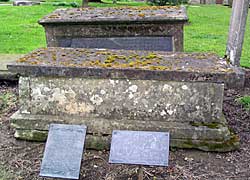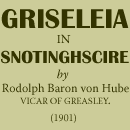< Previous | Contents | Next >
The Churchyard.
Tyack’s Lore and Legends of the Church contain some interesting anecdotes connected with churchyard watchings and their object. Whether the same was the object here we know not, nor do we know whether it was a regular custom here, or for what reason; but of one churchyard watching at Greasley we have information. It took place many years ago, and the parties engaged in it shall be nameless. One of them, whom we knew well died years ago; but the other, a very intelligent and much respected old man, is still with us. We will name the parties A and B. In his younger days A was given to innocent practical jokes; but B had a strain of fears of the supernatural in his composition, and unlike as the two were in their temperament and disposition, they were coupled together to watch the Greasley churchyard in a certain night. Said B to A when they had proceeded some little distance toward the churchyard, “Hark thee, A, I don’t owe nob’dy nothink, and I has done nob’dy no harm, but if anythink happen to we to-night, God have mercy on me soul.” “Nonsense, B,” chuckled A, “come on, it’s time we should be there.” On they trudged, B hanging a little behind until he felt he must tell A again that he owes nob’dy nothink, &c., but being both good-humouredly scolded by A as well as ‘encouraged, the two went on until they came to the Moorgreen stile of the footway leading through the fields to the churchyard. There B halted once more, and more solemnly than before reasserted his character of owing nob’dy nothink, nor having done nob’dy no wrong, and that God may have mercy on his soul if anythink happened to them that night. A stepped over the stile, and being used to B’s lagging a little behind, walked on, but after having walked some little distance looked round for his companion, when, lo! B had fairly bolted. We do not know whether he had seen anything, but we have seen him often and felt that we could credit what had been related to us, especially the first part of B’s protestations.
It does not appear that there was at Greasley, as in some churchyards of olden times, an objection to burials on the north side of the church. To the contrary, both on the north and south side of thç church, and the west as well, the churchyard was well filled with graves.
Perhaps one remarkable circumstance may deserve to be noted here about some burials near the north side of the chancel. When the new heating chamber was being excavated for there (at the before last church restoration) the workmen came upon a number of human remains, which were carefully uncovered, and each of them proved the remains of a man of uncommon stature—a number of giant brothers one might say, which were all buried in that special corner. We had the remains carefully collected in a large coffin, which we got made for that purpose, and the remains were reverently re-interred as near the place where they had been found as conveniently could be.
The Churchyard of Greasley was originally a very small one, and one might wonder how it sufficed for centuries. But the explanation is not far to seek. The Kimberley dead were not buried here until 1443, but were interred in the ancient Kimberley Churchyard, in which locality human remains have frequently been brought to the surface by the agriculturist. But even then Greasley had but a small God’s acre for the large parish. We must, however, consider that the population was small. If the list of names which we find at the beginning of the Parish Register for 1600 is that of the householders of the whole parish then the marvel is not by far so great; but independently of that, as long as burials (as was the rule) continued to be in woollen, and not in coffins, the ground was not filling up so fast, and the decay was far more rapid, so that the ground was much earlier ready again for interments than otherwise could have been. The original limits of the Greasley Churchyard were southward as far as where the large elm tree stands; eastward no further than our Churchwalk; westward to the present boundary wall; and northward as far as the boundary of the old Vicarage grounds. There was a thick holly fence separating the Vicarage kitchen garden from the Churchwalk, which was then called Black Lane, and it is said (whether true or not we know not) that suicides used to be buried under that lane. The first Churchyard extension was southward, the second from the Churchwalk eastward, and the last, in our own time, northward to the Nottingham Road. It will take about ten years more before the new ground will be filled up. Meanwhile much care is being taken to have all graves in the new ground made so deep that the families to whom they belong may for some time be able to continue burying there, even after the Churchyard should become officially closed for other burials.
As in many other old churchyards, ours could not be expected to be without some carvings of death’s heads and cross bones and an hourglass. We meet with that here both on a headstone and also on one of the four brass plates of a tomb.
There are several large tombs in our Churchyard, the panel of one of which has an inscription which illustrates in a measure how rhymes were at times forced. It reads :—“ Sacred to the Memory of Charles Maltby, who died Jan. 3rd, 1821, aged 90 years
“With successful industry he passed through life,
Attached to his children,
his friends and his wife,
And reached the advanced age of 90 you see,
Having lived an example of economy.”
There is an interesting tomb eastward from the chancel which we cannot omit mentioning. The large stone slab which covers the tomb has a line lengthwise drawn on it, on the respective sides of which are the words

Benjamin Drawater's tomb in Greasley Churchyard (Photo: A Nicholson, 2004).
“Underneath lies interred the mortal remains of Benj. Drawater, Gentleman, of Mansfield, late of Eastwood, who suddenly departed this life on the 2nd of June, 1818, in the 68th year of his age. In his professional duty he had accompanied the great circumnavigator, Cook, in the years 1772— 1775. His virtues were commendable and exemplary, and were highly esteemed by friends and relations and his surviving family. He was a pious and good Christian. He lived respected and died lamented”
On the other side of the line the Doctor’s wife is commemorated, i.e. :—
“Underneath lies interred the remains of Dorothy
Drawater, relict of
the late Benj. Drawater, who
departed this life at Nottingham on the 20th
of
May, 1818, aged 61 years.’
Another tomb betokens the resting place of the late Rev. John Hides and his wife, whose memorial tablet is in the chancel as we described it there.
The Barber family have several tombs here, under the oldest of which a vault must exist because of the several burials which (to judge from the brasses) will have taken place there. The tomb has four brasses.
1. Here lieth the body of Sarah, the wife of John Barber, who departed this life the 3rd day of March, 1710, in the 39th year of her age.
2. Here lyeth the Bodies of Mary and Elizabeth Barber, daughters of Francis and Elizabeth Barber. Mary departed this life ye 14th day of Jany., 1739, aged 5 months, and Elizabeth died Jan. ye 7th, 1744, aged 11 years.
Below these is engraved the cross bones, a death’s head and an hourglass.
3. Here lieth the Body of Sarah Raynor, Widdow, Daughter of Francis and Elizabeth Barber, who departed this life Apl. 11th, 1769, aged 36 years.
4. Underneath this stone lies the remains of Hannah, the wife of Thomas F. P. H. Barber of Lambclose House. She died the 2nd March, 1844, aged 59 years.
Also of Eliza, daughter of Thomas F. P. H. Barber, and wife of Francis Read Grammer. She died at Langton Hall, 26th of January, 1845, aged 35 years.
Also of Lucy, daughter of Francis Read and Eliza Grammer. She died at Watnall, 8th February, 1853, aged 13 years.
A red granite ledger tomb has on one side:–
“In loving Memory of Thomas
Barber of Lamb-
close House, Greasley, Notts., who died Jan. 10th,
1874,
aged 68.
Redeemed with the precious blood of Christ.”
The other side has :—
“Also in loving Memory of Elizabeth, the beloved
wife of Thomas Barber, who died June 24th, 1885.
Saved by grace through faith.”
On a marble tomb over a brick vault, on one side :—
“In loving Memory of Lavinia Bertha, the beloved
wife of Thomas Barber,
Jun., who died at Hemp
shill, near Nottingham, February 2nd, 1870, aged
25 years.”
On the other side :—
“In loving Memory of Thomas Barber of Lamb
close House (late of Hempshill),
born December
28th, 1843, died December 8th, 1893”
Next to this marble tomb is a grey granite cross, at the head of another brick vault, where lie buried two dear young children, who both lost their lives by accidents, i.e.
“Here rests in God, Kenneth Forbes, second son
of Thomas Barber of Lambclose
House, April
23rd, 1890, aged 12½ years.
Also his little sister, Cecily, August 12th, 1892,
aged 6 years and 4
months.
What I do thou knowest not now, but thou shalt
know hereafter.”
There are several large tombs of the Flint family, and a red granite one of the late R. Harrison of the Grange. The Farnworths and the Rogers family have also memorials here, as well as the family of Mr. Gge. Harrison, the Yeomans, the Gelsthorps, and many others too numerous to mentiorn The Rolleston family, since their vault in the Church has been sealed up, have a new family vault in the churchyard sufficient for eight burials.
